
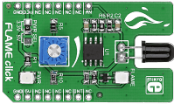
|
Flame click Released

Flame click is a fire detection solution. It carries a PT334-6B silicon phototransistor that's covered in black epoxy and therefore sensitive only to infrared light. To use it as a fire alarm, set up the exact detection threshold through the onboard potentiometer (once reached, the click will send an interrupt to the target board MCU through the mikroBUS INT pin). Othewise the sensor can also output a continuous analog signal through the mikroBUS AN pin. Flame click can use both a 3.3V or a 5V power supply.
|
2015/03/24 |


|
Rotary click (Encoder) Released

Rotary click carries a 15-pulse incremental rotary encoder with detents, surrounded by a ring of 16 green LEDs. It's a perfect solution for adding a precision input knob to your design. The encoder outputs A and B signals (out of phase to each other) on mikroBus PWM and AN lines; the knob also acts as a push-button which sends an interrupt to the target board MCU via the mikroBus INT line. The LED ring is controlled through SPI lines (CS, SCK, MISO, MOSI and RST). Rotary click can be used with either a 3.3V or 5V power supply.
|
2015/03/20 |

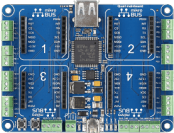
|
Quail Board Released

Quail is an STM32-powered development solution for building hardware prototypes with click boards and C# managed code. It brings together click boards and Microsoft's .NET Micro Framework for embedded devices (NETMF). Write code for your Quail projects in Microsoft Visual Studio (free in the community edition); drivers for individual click boards are provided by the MikroBUS.NET team. Hardware-wise, Quail has 4 mikroBUS sockets for click board connectivity, along with 24 screw terminals for connecting additional electronics and two USB ports (one for programming, the other for external mass storage). The board runs on a 5V power supply.
|
2015/03/12 |

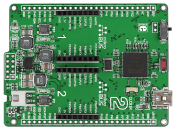
|
clicker 2 for FT90X Released

clicker 2 is a battery-powered click board with two mikroBUS sockets on board allowing you to take advantage of the huge potential of click boards. This clicker 2 is powered by FT900, a 32-bit FT32 core MCU that operates at 100MHz, has 256kB of flash, 64kB on-chip data memory, and 256kB shadow program memory. The shadow program memory is where the code is executed from, enabling the MCU to work with zero wait states at 100MHz — making it faster than many MCUs with higher clock rates. The onboard LTC 3586-1 IC will provide 3.3V or 5V to the clicks. It turns the USB port into a battery charger. For convenience, clicker 2 for FT900 features a reset button and an ON/OFF switch (you can also connect an external ON/OFF switch). clicker 2 has the same pocket-size form factor and the same pair of 1x26 connection pads as mikromedia boards. This makes it compatible with mikromedia shields letting you expand your device any way you want.
|
2015/03/06 |

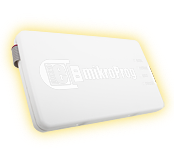
|
mikroProg for FT90x Released

Fast USB programmer and hardware debugger for FTDI Chip's FT90x devices.
|
2015/03/05 |

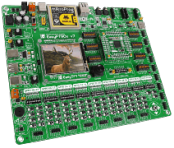
|
EasyFT90x v7 Released

EasyFT90x v7 is a full-featured development board for FTDI Chip's 32-bit FT90x devices. It contains many on-board modules necessary for developing a variety of applications, including a camera and other multimedia, Ethernet, USB, CAN and more. The on-board mikroProg programmer and debugger supports all currently available FT90x devices. The board is delivered with an FT900 MCU.
|
2015/03/04 |

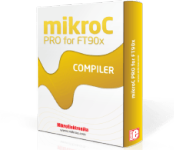
|
mikroC PRO for FT90x Released

mikroC PRO for FT90x is a full-featured ANSI C compiler for FT90x devices from FTDI Chip. It features an intuitive IDE, powerful compiler with advanced optimizations, lots of hardware and software libraries, and additional tools that will help you in your work. The compiler comes with a comprehensive Help file and lots of ready-to-use examples designed to get you started in no time. The compiler license includes free upgrades and free tech support for the products lifetime.
|
2015/03/04 |

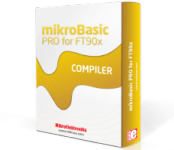
|
mikroBasic PRO for FT90x Released

mikroBasic PRO for FT90x is a full-featured Basic compiler which makes development of firmware for FT90x devices suitable for everyone. The BASIC programing language is a popular choice for beginners because of the simple syntax and clear code.
|
2015/03/04 |

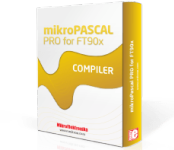
|
mikroPascal PRO for FT90x Released

mikroPascal PRO for FT90x is a full-featured Pascal compiler for FT90x devices.
|
2015/03/04 |

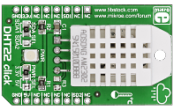
|
DHT22 click (Temperature / Humidity Sensor) Released

DHT22 click is a temperature and humidity measurement board carrying the sensor of the same name. It's a low cost reliable solution that communicates with the target board microcontroller through a single Serial Data Line. The sensor can detect temperatures between - 40 and 80 degrees centigrade with a half a degree precision. The relative humidity measurement from 0 - 100% is accurate within 2%. DHT22 has two jumpers. One for choosing between two mikroBUS pins (CS or INT) for communicating with the target board microcontroller. Another for setting up the power supply voltage either at 3.3V or 5V.
|
2015/03/02 |


|
GSM3 click Released

GSM3 click carries the SIM800H, which is a quad-band (850/900/1800/1900MHz) GSM/GPRS module that transmits voice, sms and data information. Utilizing the module's full potential, GSM3 click also has an audio input/output connection pad (for a microphone and earphones, which can also be used as an FM antenna). The SIM800H also supports Bluetooth, so a 2.4 GHz active antenna is also included on the board. Two indication LEDs signal the operating and network status of the module. The board uses a 5V power supply, but can communicate at either 3.3V or 5V voltage levels (selection by SMD jumper). An LED diode indicates the presence of power supply.
|
2015/03/02 |

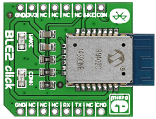
|
BLE2 click (BlueTooth) Released

BLE2 click is a simple solution for adding Bluetooth 4.1 (also known as Bluetooth Low Energy, BLE, Bluetooth Smart) to your design. It features the RN4020 module from MicroChip that has the complete Bluetooth stack and can act both as a client or a server. Additionally, the RN4020 module supports 13 public profiles and 17 public services, including the MicroChip Low-energy Data Profile (MLDP). BLE 2 communicates with the target board microcontroller through mikroBUS RX, TX and AN (CMD), PWM (CONN), and RST (WAKE) lines. The board is designed to use a 3.3V power supply only.
|
2015/02/22 |

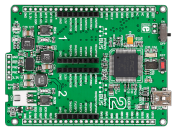
|
clicker 2 for PIC32MX Released

clicker 2 for PIC32MX is a compact development kit with two mikroBUS sockets for click board connectivity. You can use it to quickly build your own gadgets with unique functionalities and features. It carries the PIC32MX460F512L MCU.
|
2015/02/13 |

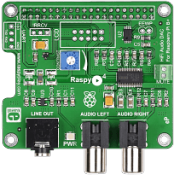
|
RaspyPlay4 (for Raspberry Pi) Released

Ever since its inception, Raspberry Pi has been a popular solution for home multimedia centers for many people. But the poor sound reproduction abilities of the Pi were a deal-breaker for anyone remotely interested in Hi-Fi. Not anymore. Play hi-quality audio from your Raspberry Pi B+ with RaspyPlay4. This add-on board features the PCM5122 DAC with excellent dynamic performance for audiophile-worthy reproduction of your favorite music, on a budget. It supports FLAC, ALAC, MP3 and WMA sound formats. Software-wise, it's compatible with several solutions, but we recommend RuneAudio. Store your favorite albums on USB flash, USB hard drive, SD Card, on a NAS server, or even stream it through AirPlay — RaspyPlay4 supports it all. Kick your feet up, relax and enjoy.
|
2015/02/12 |

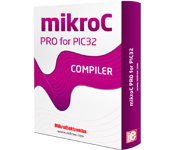
|
PIC32 Compilers v3.5 Released

Version 3.5 of mikroC, mikroBasic and mikroPascal for PIC32 brings support for 39 more MCUs, as well as new IDE features.
For more information, please click here.
|
2015/02/05 |


|
PIC32MX clicker Released

PIC32MX clicker is an amazingly compact starter development kit which brings innovative mikroBUS host socket to your favorite microcontroller. Connect the desired click board to enhance it with awesome features. It is preprogrammed with a fast USB HID bootloader. Use it to upload your firmware and the clicker will become a working device. The board features all you need to get started: 32-bit PIC32MX534F064H microcontroller, USB connector, two LEDs and push buttons, reset button, mikroProg connector and headers for interfacing with external electronics.
|
2015/02/03 |

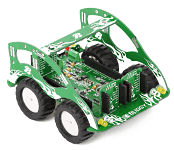
|
Buggy Released

With the Buggy, you’ll be able to develop autonomus or semiautonomus robotic four-wheelers. Just plug in a clicker 2 or mikroMedia board into the driver’s seat (that’s the onboard clicker 2 / mikroMedia socket). Then tune it up, modify and repurpose it for any task — Buggy features three mikroBUS sockets; if you put a clicker 2 in the drivers’s seat, that’s five slots for various sensors and communication boards.
|
2015/01/26 |

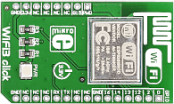
|
WiFi3 click (ESP8266) Released

WiFi3 is a complete self-contained WiFi solution carrying the ESP8266 module with a system on chip. The module has an integrated TCP/IP stack, supports Wi-Fi Direct (p2p) and boasts powerful processing and storage capabilities that offload all networking functions from the MCU. Alongside a standard mikroBUS socket, with WiFi3 click you’ll also have additional 6 GPIO pins at your disposal. WiFi3 communicates with the target board microcontroller through mikroBUS RX, TX, AN (PWD) and RST (G15) lines. The board uses a 3.3V power supply only.
|
2015/01/26 |

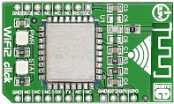
|
WiFi2 click Released

WiFi2 click is an affordable solution for adding WiFi functionality to your design, especially suited for IoT applications. The board carries the HLK-M30 WiFi module that’s easy to configure (you can set it up with either a static or dynamic IP address), and it can work both as a TCP/IP client or server. In addition, it supports multiple authentication mechanisms and network protocols. The board communicates with the target board microcontroller through UART (TX, RX), RST and ANT lines. It's designed to use a 3.3V power supply.
|
2015/01/22 |

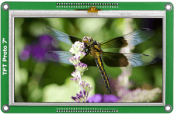
|
TFT Proto 7" Released

TFT Proto 7" carries a 800x480 FRD070IF40-A TFT screen covered with a 4-wire resistive touchscreen panel. To drive the 262k-color display, there's an SSD1963 graphic controller with a 8/9/16/24-bit MCU interface that includes a deep-sleep power saving mode (accessed through the GPIO0 pin on the side of the board). The touchpanel is driven by an advanced STMPE811 controller. The board is lined with two rows of 26 pins for interfacing it with your MCU. TFT Proto 7" uses a 3.3V power supply only.
|
2015/01/13 |

|

